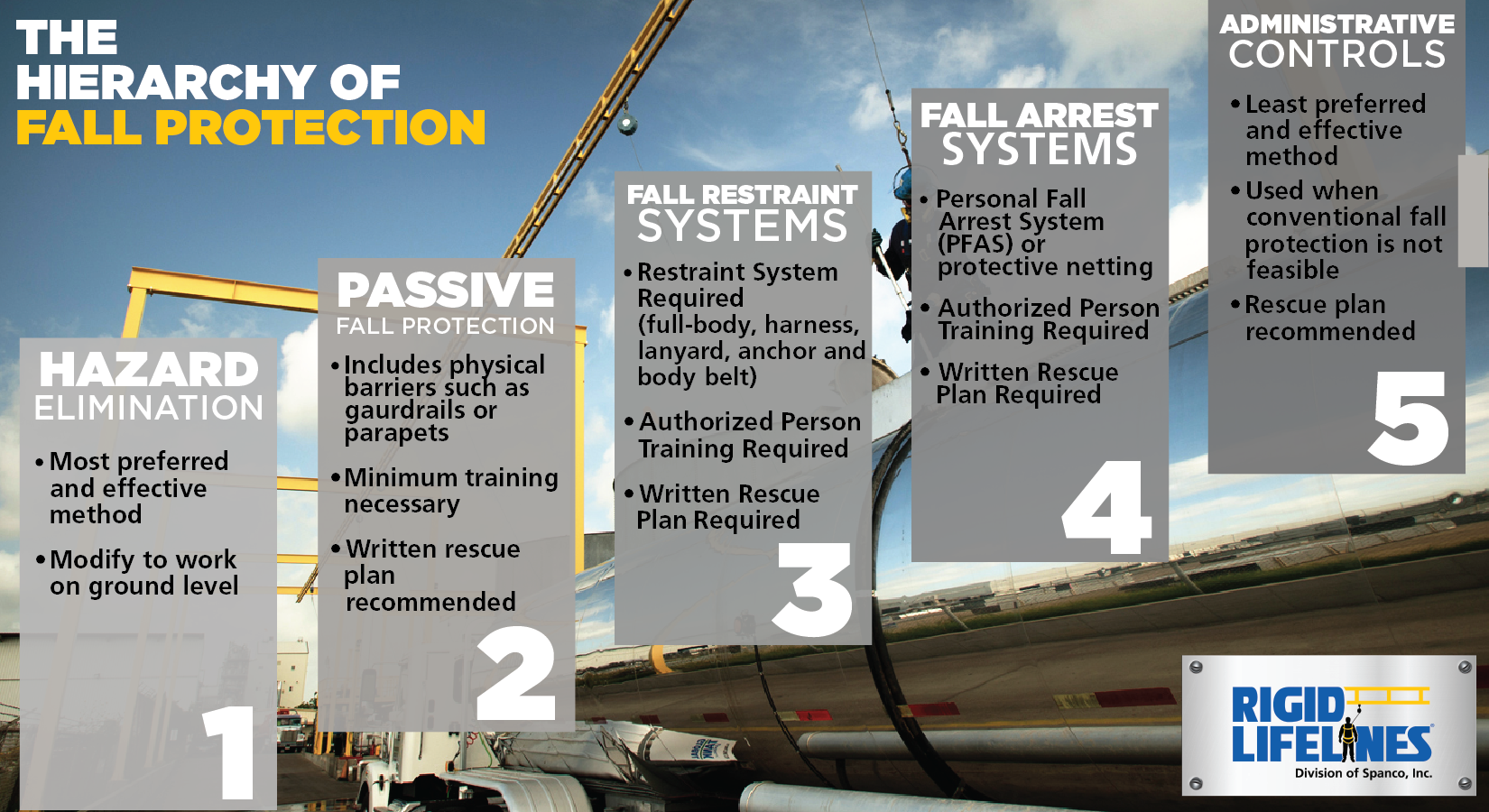
Hierarchy of Fall Protection
January 8, 2020
The term fall protection covers a broad range of topics and ideas. The Hierarchy of Fall Protection is a system intended to help select the most effective form of fall protection that can be used in any application.
Fall protection can generally be broken into two distinct groups: fall prevention and fall arrest. The first, fall prevention, is the preferred method of fall protection by any safety professional, and covers four of the five points on the Hierarchy of Fall Protection. Fall prevention as a term is fairly easy to understand; fall prevention refers to any safety measure that aims to protect workers from fall injuries by avoiding falls in the first place.
Fall Prevention
The first step on the Hierarchy of Fall Protection is elimination. Elimination simply means to find an approach to a task that does not place a worker in a position where he or she could be at risk of a fall injury. A simple example would be to have a worker use a light bulb changer pole to replace light bulbs, rather than having that worker climb a ladder to reach the bulb.
The second step is passive fall prevention. Passive fall prevention includes physical barriers that keep workers away from edges that present fall hazards. These barriers can include guardrails or railings along the edge of an upper level that keeps workers away from high-risk edges, or covers that prevent workers from falling through holes.
The third step in the hierarchy is fall restraint, or active fall prevention. Fall restraint typically uses a system that is similar to a fall arrest system; workers use full-body harnesses and lifelines that tether them to an anchor point. Fall restraint systems typically use fixed-length lifelines connected to anchor points, which restrict workers’ movement so that they can’t reach over an edge and fall to a lower level. Fall restraint systems can sometimes give workers the ability to reach closer to an edge than guardrails while still preventing the risk of a fall event.
Fall Arrest
The fourth step in the Hierarchy of Fall Protection is fall arrest, and it is distinctly different from the previous three steps. Unlike those steps, which protect workers by preventing falls, fall arrest systems protect workers by stopping them after a fall happens. Like fall restraint systems, fall arrest systems use full-body harnesses, lifelines, and anchor points. However, the lifelines on fall arrest systems are either energy absorbing lifelines (EAL) or self-retracting lifelines (SRL). These lifelines are designed to stop a falling worker safely so that he or she can be rescued after a fall event.
Fall arrest systems are not at the top of the hierarchy because the use of a personal fall arrest system still poses some risks. A fall arrest system can protect a worker from falling to a lower level, but that worker must be rescued quickly to avoid other risks. The biggest risk posed by fall arrest systems is suspension trauma. Another risk can come from the environment where the fall arrest is used; leading edges can cause equipment to fail, so it is imperative to find the correct SRL for specific applications. However, some situations require fall arrest when the preferred fall prevention solutions can’t be provided.
Administrative Controls
The last step in the fall protection hierarchy is administrative controls, which is the least preferred solution and not recommended as the primary method of fall protection if any other solution is possible. Administrative controls do not provide any actual physical protection to workers. Instead, administrative controls are work practices or procedures that train workers to avoid fall hazards. This approach leaves the safety of individual workers up to their own actions, which is why safety professionals recommend using more preferred methods unless it is absolutely necessary to rely on administrative controls.
The Hierarchy of Fall Protection exists to help determine the best method of protecting workers at height. The first step in the hierarchy should always be considered to be the best option and should be used whenever possible. Each subsequent step should be considered only if the preceding steps are not viable for a certain situation. By following this hierarchy, you can help provide the most effective form of fall protection available for any application.

Categories
Share this post
Let us help you
Contact us today to find the perfect product fit for your job
